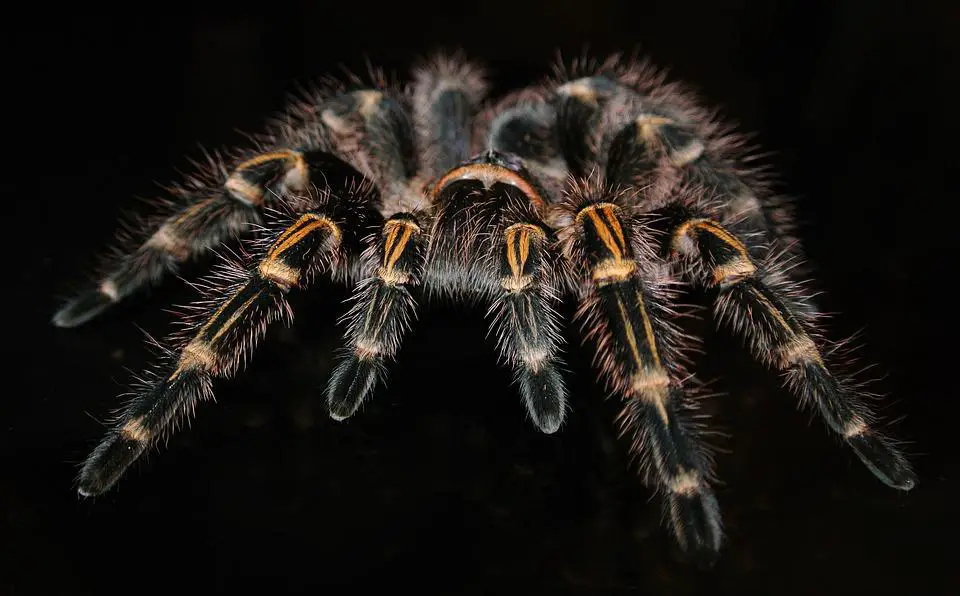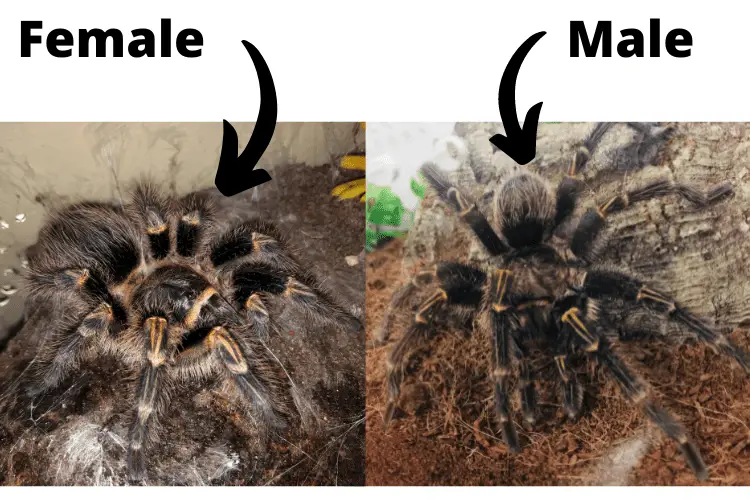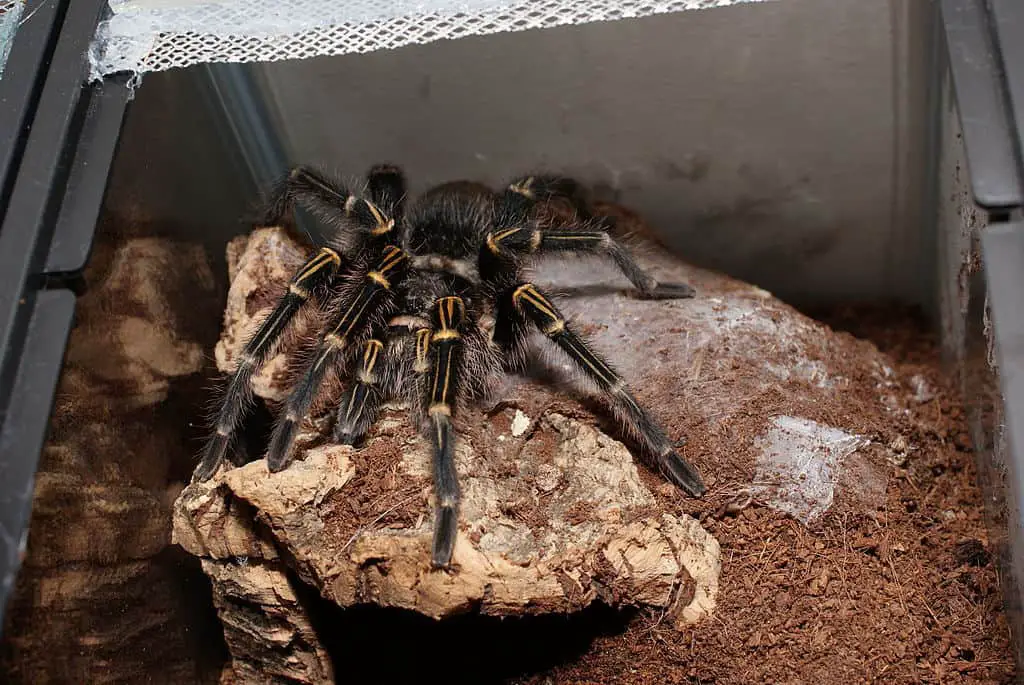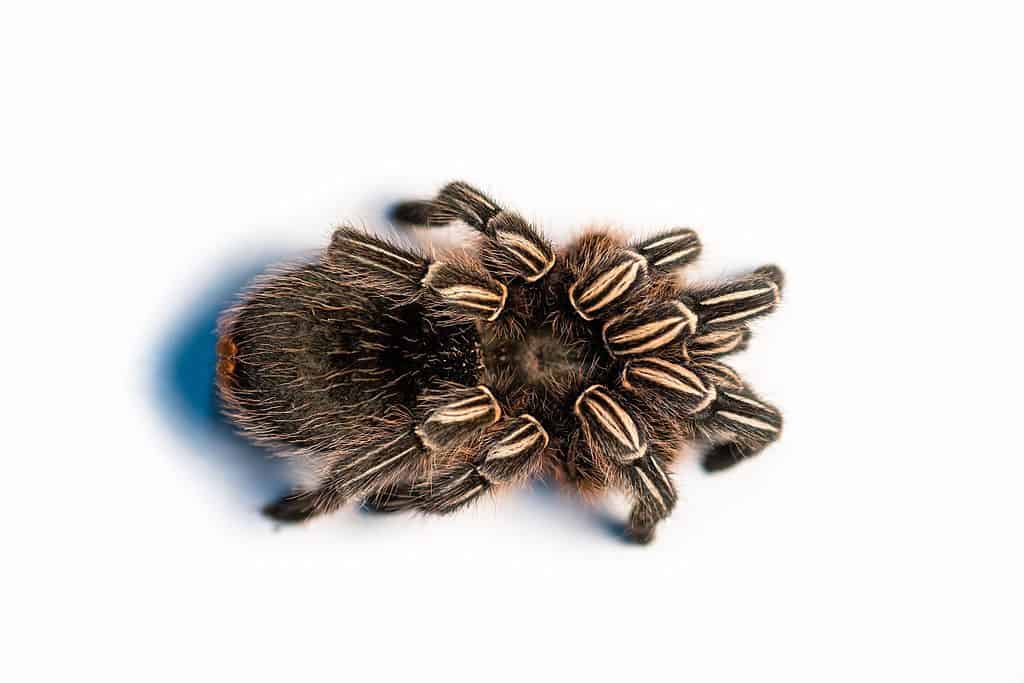The Chaco Golden Knee Tarantula (Grammostola pulchripes) is a New World terrestrial species. They’re endemic to Paraguay and Argentina, where they live in the grasslands. This spider is best known for its long lifespan, large size, and beautiful color pattern. Their primary color is black with yellow spots on their legs, which is how they got their name.
If you’re considering adding a Chaco Golden Knee Tarantula to your collection or would simply like to learn more about them, you’ve come to the right place because today we’ll go over everything you need to know about these fantastic tarantulas!

Chaco Golden Knee Care Sheet
| Species Name | Grammostola pulchripes |
| Family Name | Theraphosidae |
| Common Name | Chaco Golden Knee Tarantula |
| Category | New World |
| Type | Terrestrial |
| Native Location | Paraguay & Argentina |
| Leg Span | 7.5 to 8.5 inches (20-22 cm) |
| Growth Speed | Medium |
| Urticating Hairs | Yes |
| Social | Solitary |
| Diet | Insects: crickets, roaches, mealworms |
| Temperature | 68 to 78 degrees Fahrenheit |
| Humidity | 70 to 80% |
| Life Expectancy | Female: 20 to 25 years / Male: 5 to 10 years |
| Experience required | Beginner |
| Minimum tank size | 20”L x 10”W x 18”H (15-gallon tank) |
Chaco Golden Knee Tarantula overview
The Chaco Golden Knee, scientifically known as the Grammostola pulchripes, is an incredibly large tarantula that roams the forest floors of Argentina and Paraguay. Since they are a New World species they have urticating hairs, which they can release when they feel threatened.
When they are young they tend to burrow. However, as they get older, they tend to take a pre-existing hide as their home.
Their scientific name Grammostola pulchripes stems from the Latin words Pulchra and pes. These words mean beautiful and foot, which is an apt description for the species if you ask me.
Appearance & Varieties

The Chaco Golden Knee has a dark body with interesting yellow markings on the legs. These markings are located all along the legs, and on the black backdrop, they look almost golden, which is where the spider gets its name from. They also have pink urticating hairs on their legs and abdomen.
As slings, they are brownish in color without any markings on their legs they don’t get their mature coloration until they’re older.
the Chaco Golden Knee is an incredibly large tarantula that tops out at a size of around 8.5 inches in leg span.
As is common in spiders, males are quite a bit smaller than females. They have a much smaller body but typically have longer legs. Another interesting distinction between males and females is that males have tibial hooks. They have these to keep the female’s fangs at bay during the mating process.
Price
The price for a Chaco Golden knee depends on a couple of factors. First, slings are typically much cheaper than adults. The reason is that they’re much more difficult to raise and take care of. They’re also quite slow growers, which means that it could take years for a sling to be fully grown and show all its beautiful colors.
Secondly, males are often much cheaper than females. The reason for that is obvious, females live much longer, making them much more highly desired.
Luckily though, since the Chaco Golden Knee Tarantula is a relatively common species they’re not all that expensive. You can easily buy a sling for about $50, a female juvenile for around $100, and a female adult for around $400.
Of course, there are also some other costs associated with owning one of these animals, such as buying an enclosure, substrate, and food, but these costs are relatively low.
Behavior & Temperament

The Chaco Golden Knee Tarantula is an extremely calm and docile species. Their size might be intimidating, but they’re truly gentle giants. They’re not prone to showing defensive behavior. They prefer to run away rather than fight.
Threat postures or the release of their setae are almost never seen from the CGKT. Also, they almost never bite, but if they do bite, their venom is very mild.
They’re terrestrial opportunistic burrows. What this means is that they tend to burrow quite frequently when they’re young but this behavior tends to go away as they grow. When they’re fully grown they tend to stop burrowing completely and adopt an existing hide that you place in their enclosure as their home.
Due to their large size, beautiful colors & patterns, slow-moving speed, and tendency to sit out in the open, they’re excellent show spiders. Furthermore, the fact that their temperament is very calm makes them an excellent species for beginners to the hobby.
Chaco Golden Knee Tarantula Care
The Chaco Golden Knee Tarantula is a very low-maintenance pet. It requires a simple enclosure, infrequent feeding, and not much else. However, while they might be low-maintenance, there are some things that you must know to properly care for them.
Habitat setup
Since the Chaco Golden Knee is a large tarantula they need a relatively spacious enclosure. At a minimum, an adult needs a terrarium that’s 20 inches long, 10 inches wide, and 18 inches high. Slings and juveniles can be in much smaller enclosures but make sure that their habitat grows with them.
When selecting an enclosure for a terrestrial species such as these, length is always most important than height.
Substrate
Chaco Golden Knee Spiderlings and juveniles need enough substrate to burrow, which is around 2″. Adults typically do not burrow, but they do need a layer of substrate that’s at least 5″.
Good materials to use as substrate include vermiculite and peat moss. do make sure that the substrate is organic and free of any fertilizers. Make sure to avoid sand, pebbles, rocks, or wood chips as substrate. These can cut your tarantula and are not comfortable for them.
Foliage & Decor
It’s essential that you provide the Chaco Golden Knee with a hide, especially as adults. Hides can be cork bark, a simple half log, or a coconut shell. If you don’t have any of these and don’t want to buy them, a plant pot can also suffice.
You can also put some rocks and plastic plants in their enclosure to spice up the interior a little.
Temperature and humidity
The Chaco Golden Knee Tarantula does best at temperatures between 68 and 78 degrees which is around room temperature for most homes. As for humidity, they’re not all that picky. As long as you prevent the air from getting too dry they will do okay. Slings prefer substrate that’s a bit moist, while adults prefer drier substrate.
Social
While the Chaco Golden Knee is docile and sociable towards humans, they do not tolerate other tarantulas in their habitat. They will perceive this as an intrusion and cannibalism will occur if you try to house more than one of these spiders together.
In the wild, they only meet to breed and even that often ends in the male being eaten. Do not try to house two of them in the same space as this will not end well.
If you want a communal setup, only do so with species that are suitable for it like the Trinidad Olive or Socotra Blue Baboon.
Molting
Molting is a process that every spider goes through as they grow. They shed their exoskeleton to make way for a bigger one. Since the Chaco Golden Knee is a slower-growing species they will molt less frequently. Signs that your tarantula is about to molt include refusing food and darkening of the abdomen.
After the molting is done, they will typically also refuse food for a few days. This is because they need time for their fangs to harden before they can eat.
Feeding & Watering

Like all tarantulas, the Chaco Golden Knee Tarantula is most often fed a diet that consists entirely of insects, though some owners feed them the occasional mouse or gecko.
Which insects and how often they should eat depends on their age.
Slings should eat every 5 to 10 days. Make sure that you feed them food that is small enough for them to overpower. Good options include flightless fruit flies or baby crickets.
Adults should eat less frequently. Feeding them 4-5 adult crickets once every 7 to 14 days is enough. They can eat a variety of insects such as crickets, roaches, and mealworms.
The amount that they need to eat depends on their size and activity levels. Large adult females need to eat more than males. A good way to keep an eye on whether you’re over or underfeeding your spider is by looking at their abdomen. If it’s shrinking you should increase the amount of food you give them, if it’s growing, you might want to tone down the feeding a little bit.
As far as watering goes, large specimens over 2″ in size should be able to drink from a shallow water bowl. Make sure to rinse and refill it frequently to avoid the build-up of bacteria. Slings and small juveniles that cannot drink from a water bowl yet can drink from drops that you drip down the side of the enclosure.
Health & Lifespan
The Chaco Golden Knee Tarantula does not have much to fear in captivity, which is why they have such long lifespans. Females can live for up to 25 years while males can live for up to 10 years.
The only things that might pose a problem to them in captivity are parasites, mites, and falls. To avoid these, make sure that you clean their enclosure frequently, do not feed them wild-caught insects, and prevent their enclosure from being so high that they can have damaging falls. Adequate ventilation is also important to keep their enclosure free of bacterial growth.
Chaco Golden Knee Tarantula Facts
- The Grammostola pulchripes was first described in 1892.
- This species used to be called the Grammostola aureostriata, which is derived from the Latin words aureus “golden” and striatus “striped”.
- The current “pulchripes” name comes from the Latin word “pulchra” which means beautiful and “pes” meaning foot.
Final words
Whether you’re new to the hobby or have plenty of experience, the Chaco Golden Knee is a beautiful species that makes a great addition to any collection.
Their massive size, stunning appearance, docile nature, and tendency to spend a lot of time out in the open makes them excellent show spiders and they’ve deservedly gained a reputation as great first-time species. They’re easy to care for and magnificent to observe, what’s not to love?
- How Long Do American Eskimo Dogs Live? Important Factors and Care Tips - September 29, 2023
- Do American Bulldogs Need Grooming? Essential Tips and Care Guidelines - September 29, 2023
- Do Bengal Cats Enjoy Playing? Essential Tips for Keeping Them Active - September 29, 2023